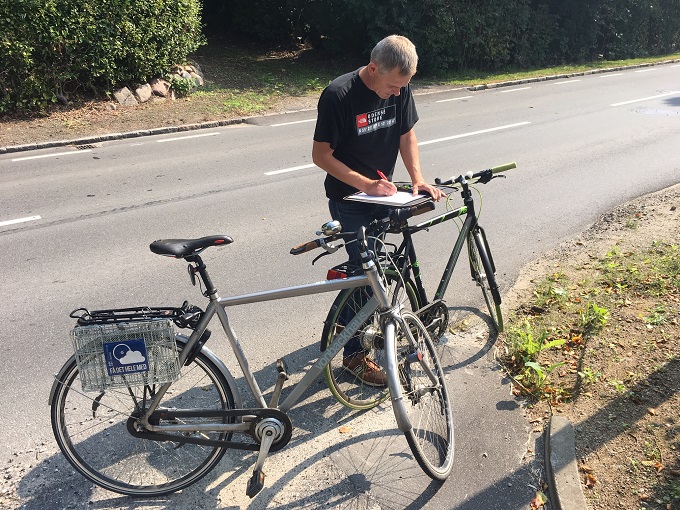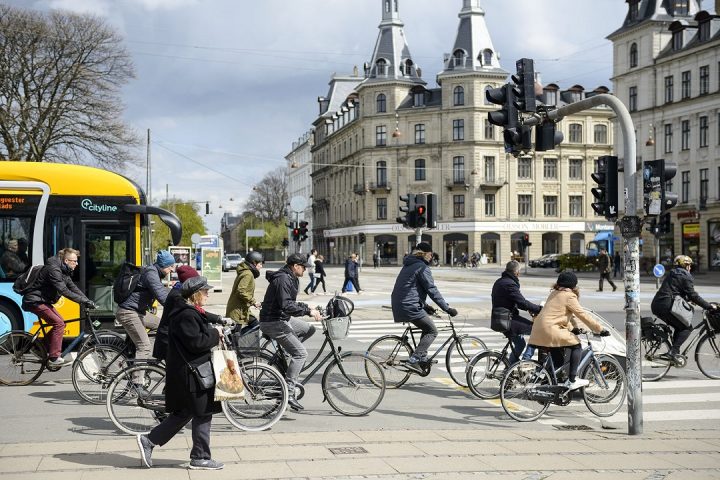Traffic safety audits and service levels
Traffic safety must be up to standard, and one way of ensuring this is by an impartial traffic safety audit. You can start by doing a bicycle inspection yourself. Calculating cyclist service levels can also be part of the project planning.
By Troels Andersen, Odense Municipality
Start by finding the general recommendations for safe solutions for cyclists. Most of them are discussed in the present collection of articles. To kick off the project you should always do a bicycle inspection, preferably with a colleague or a consultant. Basic maps and Google Street View are great, but you see much more on-site. There will always be concrete observations that should be included in the project. Here are some general recommendations that often come up:
- Sufficient visibility – can the different parties see each other and do they have time to react?
- Space for cyclists – if cyclists have enough space they will typically wait for traffic.
- Reduce speeds – so road users can stop before the accident
Cycling projects are often assessed by a traffic safety audit. This is done to ensure an impartial assessment of the project’s estimated safety effect, and to identify and consider possible safety issues. The work is done by specially trained road safety auditors.
Road safety audits can be carried out at different times during the planning process, from the conceptual design to the completed construction. Some local authorities choose to only audit the finished project whereas others may prefer an assessment of the conceptual design.
In an ideal situation a project is safe and promotes bicycle traffic at the same time. Traffic safety audits are solely concerned with safety, and thus do not address other elements which in practice may play a role in the design of cyclist traffic areas. It’s not easy to ignore a traffic safety audit recommendation, but nevertheless this may sometimes be the right thing to do taking the situation as whole.

- No way around it! You and your colleagues need to get on your bikes to inspect and assess concrete conditions on-site.
As yet there are no suitable tools for charting security and accessibility. In addition to the traffic safety audit, the road rules tools for calculating perceived service levels can be used to gauge cyclist satisfaction on the individual road stretch and intersection within a larger network. The tools are based on relatively little information about road design, general surroundings, and traffic. The general quality parameter for cyclist satisfaction is closely connected with security and accessibility. The service level tools may be used to identify the intersections and road stretches that are most unsatisfactory, and to estimate what effect reconstruction will have on satisfaction.
The tools can also be used to optimize service level improvements during reconstruction in order to get as many satisfied road users as possible for the money.
Traffic safety audits
Traffic safety audits make it possible to detect accidents before they happen. A traffic safety audit helps the local authority guarantee the quality of a project before it is actually constructed and put into operation. A traffic safety audit is a systematic, independent examination of the safety of road and traffic projects.
There are five steps in a traffic safety audit:
- Step One: Conception phase. Examination of the basic conception of the project in the planning phase before the plan is approved and made public
- Step two: Conceptual design phase. Examination of the route, cross profile, intersections, etc. prior to political approval of the project
- Step 3: Construction plan phase. Examination of the details of intersection design, markings, lighting, immovable objects,, etc. before tenders are made public
- Step 4: Commissioning phase: Examination of the completed project for visibility, surface, marking, etc. directly prior to or after the opening
- Step 5: Monitoring phase. Examination of the construction’s function, accident data, etc. approx. a year after it was put in operation –before the one year defects liability period runs out.
Checklist for traffic safety audit – with a focus on cycling
- Has the positioning of left -turning cyclists at intersections been taken into account?
- Does the signalization system take sufficient account of cyclists (clearing time in headwinds and uphill, and possibility of single phase crossing?)
- Is there a need for special cyclist phases (max. waiting times, pre-green for right-turning motor traffic should be avoided, and can cyclists wholly or partially be excepted from signal control, for example in right turns?)
- Is the placement of electronic detectors in the approach appropriate and sufficient?
- Is the coordination with other nearby signals appropriate?
- Has the correct type of intersection been chosen and in the case of an intersection on the same level, have blue cycle crossings been taken into account?
- Does the road user’s route through the intersection appear clear in all directions and for all maneuvers?
- If there is a refuge island, and is it wide enough for waiting cyclists?
- Are there gullies/grates along the cyclist’s route?
- Will motorized road users be aware that they are crossing a two-way cycle track?
- Are barriers or speed bumps necessary on the cycle track to clarify right of way? Barriers, etc. may constitute a collision risk for cyclists.
- Are there safe waiting facilities for bus passengers getting on and off the bus? And are the waiting areas wide enough? Bus platforms should be minimum 1.5 m wide, and designed so they are clearly not part of the cycle track.
- Are special measures necessary to indicate who has the duty to give way between bus passengers and cyclists, for example, raised surfaces, reflectos, special surface colors, rumble strips, etc.?
- Is the road surface in acceptable condition at intersections and adjacent cyclist areas?
- Are mopeds allowed on cycle tracks? If so, are special measures necessary to traffic calm them?
- Is additional separation necessary between the cycle track and parked cars to minimize risk when doors are opening?
- Two-way cycle tracks along the road should be avoided unless there are very few side roads/private driveways.
Sources
Trafiksikkerhedsrevision, håndbog, 2015
Fodgængeres og cyklisters oplevede serviceniveau i kryds, Trafitec, 2011








